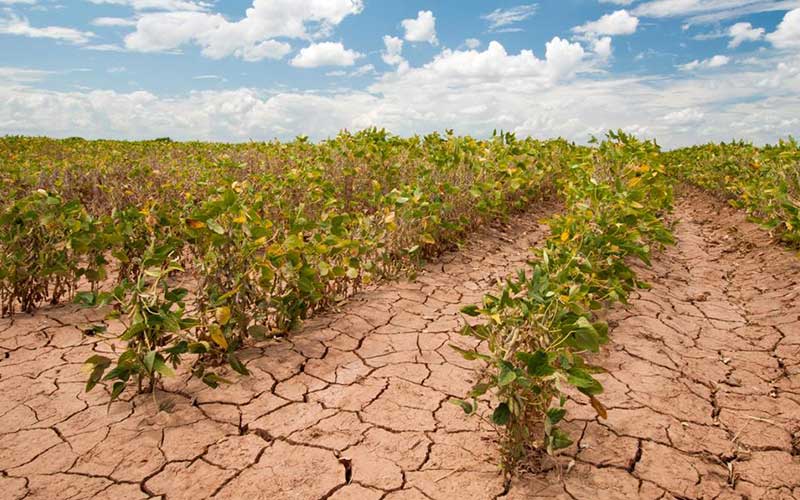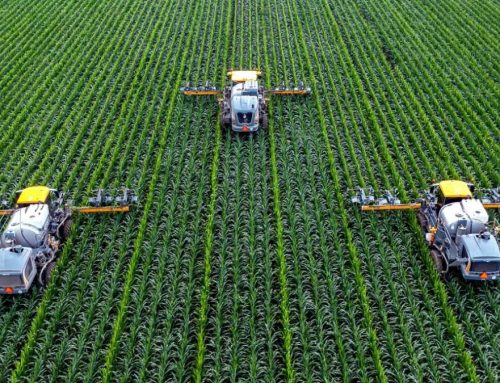Climate change is a global phenomenon that refers to the long-term alterations in the Earth’s climate systems, including temperature, precipitation, wind patterns, and other measures of weather over several decades or longer. These changes are caused by a combination of natural and human factors, such as volcanic eruptions, solar radiation, and human activities like the burning of fossil fuels, deforestation, and industrial processes that emit greenhouse gases into the atmosphere.
The agricultural industry is one of the most critical sectors of the global economy, providing food, fiber, and other resources to millions of people worldwide. Agriculture is heavily dependent on natural resources such as water, soil, and climate, which makes it highly vulnerable to the impacts of climate change. Changes in temperature and precipitation patterns, droughts, floods, and other extreme weather events have significant implications for crop production, livestock, and the livelihoods of farmers and rural communities.
The impact of climate change on agriculture is a complex and multifaceted issue that requires a comprehensive understanding of the interrelationships between the environment, the economy, and society. While there is still much uncertainty about the exact nature and extent of these impacts, it is clear that they will have far-reaching consequences for food security, poverty, and social and economic development. Therefore, it is essential to examine the link between climate change and agriculture, understand the challenges and opportunities that arise from this relationship, and explore strategies to mitigate and adapt to these impacts.
How climate change affects agriculture
Climate change is having a profound impact on agriculture, disrupting traditional farming practices and threatening global food security. Changes in temperature and precipitation patterns are among the primary ways in which climate change affects agriculture.
Rising temperatures and heatwaves can negatively impact plant growth and development, reduce photosynthesis, and increase water demand. Crops are sensitive to temperature changes, and even small increases in temperature can result in decreased yields and lower-quality produce. On the other hand, colder temperatures can also pose a threat to crops, especially those that require a specific temperature range to grow optimally.
Precipitation patterns are also being affected by climate change, leading to droughts or floods in some regions. Changing precipitation patterns and prolonged drought can lead to soil degradation, erosion, and reduced crop productivity. Soil erosion is a critical issue in areas where rainfall patterns have become more intense or unpredictable, as it can strip away the nutrients necessary for plant growth.
Climate change also increases the frequency and intensity of extreme weather events such as hurricanes, floods, and droughts. These events can destroy crops, cause soil erosion, and reduce the availability of freshwater for irrigation, livestock, and drinking. The effects of climate change are compounded by the increased prevalence of pest and disease outbreaks, which can destroy crops and livestock.
In addition to the direct impacts of climate change on agriculture, indirect impacts include changes in water availability, land use, and market demand. Climate change can cause water scarcity in regions that rely on melting snowpacks and glacier-fed streams for irrigation. Land use patterns may also shift as farmers seek new areas to grow crops, leading to deforestation, habitat destruction, and soil degradation.
Overall, the effects of climate change on agriculture are numerous and complex, threatening the livelihoods of farmers and food security globally. It is crucial to develop adaptive strategies to mitigate these impacts and ensure sustainable and resilient agriculture for future generations.
The consequences of climate change on the agricultural industry
Climate change has severe consequences on the agricultural industry, affecting both crop and livestock production, and posing significant challenges to food security and economic growth. Here are some of the consequences of climate change on agriculture:
- Decreased crop yields and quality: Rising temperatures, altered rainfall patterns, and extreme weather events such as floods, droughts, and heatwaves affect crop growth and reduce yields. Pests and diseases also thrive under these conditions, further compromising crop production. Additionally, the nutritional quality of some crops can be affected, which can have significant consequences for human health.
- Reduced livestock productivity: Climate change affects the availability and quality of feed, water, and pasture for livestock, leading to decreased productivity and lower reproductive rates. Heat stress and disease outbreaks can also impact animal health and wellbeing.
- Increased food insecurity and poverty: Climate change exacerbates existing food insecurity, particularly in regions already affected by hunger and malnutrition. Smallholder farmers, who rely heavily on rain-fed agriculture, are particularly vulnerable to climate change impacts, leading to increased poverty and vulnerability.
- Economic losses for farmers and agribusinesses: Crop failures, loss of livestock, and reduced yields and quality can lead to significant economic losses for farmers, agribusinesses, and the wider food supply chain. This can lead to job losses, reduced incomes, and lower economic growth in rural areas.
- Displacement of farming communities: Climate change-induced disasters such as floods and droughts can lead to the displacement of farming communities, leading to social and economic dislocation.
Overall, the consequences of climate change on agriculture pose significant challenges to global food security and economic development, particularly in vulnerable regions of the world. Without adequate adaptation and mitigation measures, the agricultural industry and the people who rely on it for their livelihoods are at risk.
Adaptation and mitigation strategies
Climate change has already had a significant impact on the agricultural industry, and its effects are expected to intensify in the future. To mitigate the impact of climate change on agriculture and adapt to the changing climate, various adaptation and mitigation strategies have been developed. These strategies are aimed at enhancing the resilience of farming systems, reducing greenhouse gas (GHG) emissions from agriculture, and increasing food security.
- Improving soil management practices: Healthy soils can help mitigate the impact of climate change by increasing soil organic carbon (SOC) sequestration, reducing GHG emissions, and enhancing the resilience of cropping systems. Adopting conservation agriculture practices such as minimum tillage, cover cropping, and intercropping can help improve soil health and increase SOC sequestration. Soil testing and precision nutrient management can also improve soil fertility and reduce nutrient losses to the environment.
- Developing drought-resistant crops: The changing climate is expected to lead to increased frequency and severity of droughts in many regions. Developing drought-resistant crops through breeding or genetic engineering can help farmers cope with water scarcity and maintain crop productivity. Additionally, the use of drip irrigation and other water-saving technologies can help reduce water use in agriculture.
- Implementing water conservation and irrigation techniques: Water is a precious resource, and with changing climate patterns, water scarcity is becoming a significant concern. The implementation of water conservation and irrigation techniques can help farmers use water more efficiently. These techniques include rainwater harvesting, constructing small reservoirs or ponds, and using low-pressure drip irrigation systems.
- Enhancing pest and disease management: Climate change is expected to exacerbate pest and disease pressures on crops and livestock. Integrated pest management (IPM) techniques, including biological control and cultural practices, can help reduce the use of pesticides and improve pest and disease management. This, in turn, can help reduce the environmental impact of agriculture and improve food safety.
- Adopting climate-smart agriculture practices: Climate-smart agriculture (CSA) is an integrated approach to agriculture that aims to increase productivity, reduce GHG emissions, and enhance resilience to climate change. CSA practices include sustainable land management, agroforestry, crop diversification, and livestock management.
Adaptation and mitigation strategies are essential to help the agricultural industry cope with the impacts of climate change. These strategies should be implemented in a way that enhances the resilience of farming systems, reduces GHG emissions, and increases food security. Governments, the private sector, and civil society all have a role to play in supporting the adoption of these strategies and ensuring their widespread implementation.
Policy and institutional responses to climate change in agriculture
Climate change is a global problem that requires coordinated action from governments, institutions, and stakeholders in all sectors, including agriculture. In recent years, several policy and institutional responses have emerged to address the impacts of climate change on agriculture and support adaptation and mitigation efforts. In this section, we will discuss some of the key policy and institutional responses to climate change in agriculture.
National and international policies and initiatives
Governments around the world have recognized the urgent need to address the impacts of climate change on agriculture and have developed various policies and initiatives to support adaptation and mitigation efforts. For instance, the United Nations Framework Convention on Climate Change (UNFCCC) provides a global platform for countries to collaborate and develop policies and initiatives to address climate change. The Paris Agreement, a landmark agreement signed in 2015, aims to limit global warming to well below 2 degrees Celsius and pursue efforts to limit the temperature increase to 1.5 degrees Celsius above pre-industrial levels. The agreement also recognizes the importance of agriculture in addressing climate change and calls for the development of sustainable agriculture practices.
Many countries have also developed their own policies and initiatives to address climate change in agriculture. For instance, in the United States, the USDA Climate Hubs provide technical assistance to farmers and ranchers to help them adapt to climate change. In India, the National Action Plan on Climate Change (NAPCC) includes several programs to support sustainable agriculture and climate-smart practices. In Kenya, the Climate-Smart Agriculture Program aims to increase agricultural productivity and resilience to climate change.
Funding and support for research and development
Research and development are critical for developing sustainable and resilient agriculture practices that can adapt to and mitigate the impacts of climate change. Many institutions and organizations provide funding and support for research and development in climate-smart agriculture. For instance, the CGIAR Research Program on Climate Change, Agriculture, and Food Security (CCAFS) supports research on climate-smart agriculture and works with partners to develop and scale up climate-smart practices. The Bill and Melinda Gates Foundation also supports research and development in sustainable agriculture through its Agricultural Development program.
Capacity-building and knowledge-sharing
Capacity-building and knowledge-sharing are also essential for supporting adaptation and mitigation efforts in agriculture. Many institutions and organizations provide training and education programs to farmers and other stakeholders to help them adopt climate-smart practices. For instance, the Food and Agriculture Organization of the United Nations (FAO) provides training programs on climate-smart agriculture and supports knowledge-sharing through its Global Alliance for Climate-Smart Agriculture. The Climate Smart Agriculture Youth Network (CSAYN) also provides capacity-building and networking opportunities for young people working in agriculture and climate change.
Policy and institutional responses are essential for addressing the impacts of climate change on agriculture and supporting adaptation and mitigation efforts. National and international policies and initiatives, funding and support for research and development, and capacity-building and knowledge-sharing are all critical components of a comprehensive response to climate change in agriculture. It is important that governments, institutions, and stakeholders work together to develop and implement effective responses to the challenges posed by climate change in agriculture.
Conclusion
The impact of climate change on the agricultural industry is a pressing issue that requires urgent action. The consequences of climate change on agriculture, such as decreased crop yields, reduced livestock productivity, and increased food insecurity, pose a significant threat to global food security and the livelihoods of millions of people.
However, by implementing adaptation and mitigation strategies, and with the support of policies and institutions, sustainable and resilient agriculture can contribute to climate change mitigation and adaptation efforts. It is essential to prioritize investments in climate-smart agriculture practices to build a more resilient and sustainable food system for the future.






